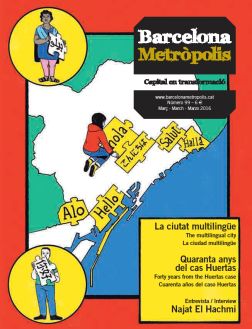 Barcelona. Publicitat i ephemera
Barcelona. Publicitat i ephemera
[Barcelona. Advertising and ephemera]
Authors: Víctor Oliva Pascuet, Oriol Oliva Sanosa
Barcelona City Council
Barcelona, 2015
The writer Josep Pla said that we Catalans get lost in aesthetics. This book is testament to that. It is a collection of prints, but also an expression of the most popular aesthetics, an account of the quality of the communications professionals of the past and of the roots of Catalan graphic design.
It should be remembered that Barcelona is one of the most important cities in the history of European advertising. In 1857, Roldós Viñols opened the first advertising agency in Spain, and the new professionals demonstrated a modernity and a capacity to innovate on the level of quality of Paris or London.
How is it possible to make such a beautiful book from a few very humble sheets of paper? The authors discuss the difficulty of organising this “jigsaw” of images that represents a “graphic archaeology” of Barcelonian advertising. These 590 pages represent 20 years of cataloguing work by Víctor Oliva, one of the top book and catalogue designers in Catalonia. An illustration of ephemeral advertising, since the nature of an ad is to make an impact and then disappear. Still, all these product brochures, posters and product wrappers have a deep cultural impact in our memory, and collectors such as Oliva help us discover new meaning there. Is it nostalgia? Perhaps, but when the pieces of the jigsaw are put together we see the beauty of the whole, the story of everyday life through the products. This book requires slow, careful reading. Its pages are showcases, because this collection of advertising cannot be read like a normal book; instead, it is a museum of graphic arts and the history of our advertising.
In his 1917 book Una nueva técnica: la publicidad científica (A new technique: scientific advertising), Pere Prat Gaballí, the father of modern advertising, said, “Advertising sets out to create desires and needs: to do this, it has to work on sensitivity.” It is an activity with an educational nature that teaches the value of products and brands. In the prints in this book, we understand the words of the first theorist in the discipline in Spain, and we discover the aesthetic mechanisms of advertising prior to the 1960s, before the birth of the Mad Men of contemporary 20th-century marketing and the advertising agencies of Tuset Street.
The authors organise the book into themed chapters. They create a hybrid between product advertising and sectorial advertising, but it is not organised as a lesson on brands: the aim is to underscore the role of the artists, not the messages. Each chapter has its own closing text by Víctor Oliva, Oriol Oliva, Santi Barjau, Jaume Bosch, Albert Domènech or Jaume Capdevila, short summaries to highlight technical or cultural aspects.
All the great artists are there, but the best part is recovering the small pieces, the labels, the catalogue covers, the point-of-sale displays and the fans of different types. All these prints that we would currently call unconventional advertising. Advertising that is always modest, but that includes a deep love for communication, a homage to often anonymous pioneers who are as unconventional as this work.



